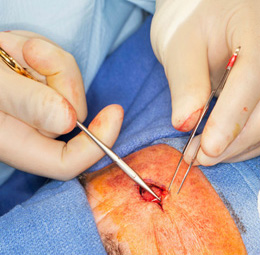Surgical
There are 2 main surgical treatments for skin cancers, and these are usually able to be performed at our centre under local anaesthetic. This avoids unnecessary hospital visits and helps to keep costs to a minimum.
Curettage
Is a traditional treatment that is very effective for treating many superficial skin cancers. It involves surgically scraping off the skin cancer and then allowing the resulting ulcer to heal up from underneath. It is performed under local anaesthetic and does not require stitches. The wound usually heals with a flat pink to white scar, which is generally acceptable on the trunk or limbs. It is not used very often on the face and is not used to treat melanoma skin cancers. If you are treated with curettage you will have a band-aid type dressing applied. This is usually left on for 2 days and then removed and the wound washed in the shower. After washing the wound should be dried with a clean cloth and then a new band-aid applied. This is repeated every day until a scab forms. Once the scab forms the area can be left uncovered, however a daily moisturising cream should be applied until the wound heals up, which is usually about 3 weeks later. Sometimes a special dressing called Duoderm is used to help with the healing process.
Excision
This is the best treatment for most skin cancers, including melanoma. It involves surgically removing the en
tire block of skin cancer along with a healthy margin of normal skin beside and below the skin cancer. It is performed under local anaesthetic and is repaired with stitches. The wound usually heals with a flat pink to white linear scar. The position of the scar is placed to correspond with natural skin creases and wrinkles so that it blends in with the surrounding skin as best as possible. Most excisions are able to be undertaken in the rooms at the centre which avoids a hospital stay. Patients are generally able to drive home and go to work the next day. If you are treated with excision you will have a band-aid type dressing applied. This is usually left on for 2 days and then removed and the wound washed in the shower. It is generally safe to get your wound wet and you may leave your wound uncovered after the second day provided that you keep applying a moisturizing ointment to the wound each day. Some wounds are best kept covered with a band-aid dressing, especially if you are likely to get the wound dirty at work, or if clothing is rubbing on the stitches. You will need to see your doctor 7 to 14 days after the procedure for removal of stitches.


